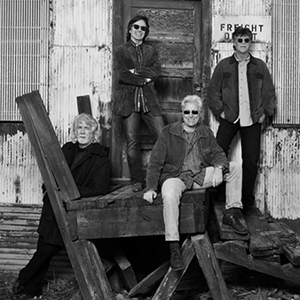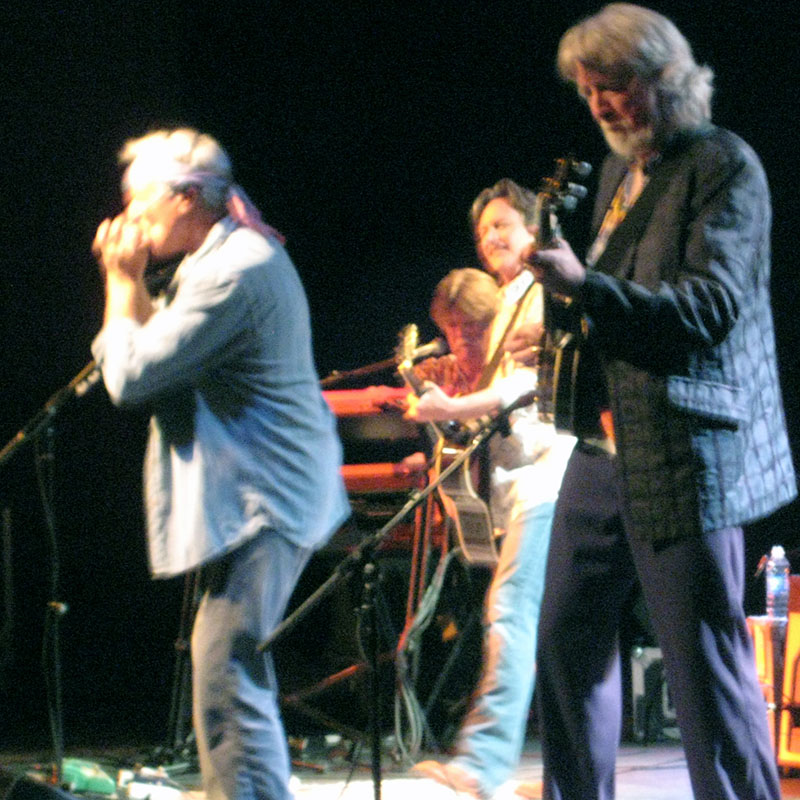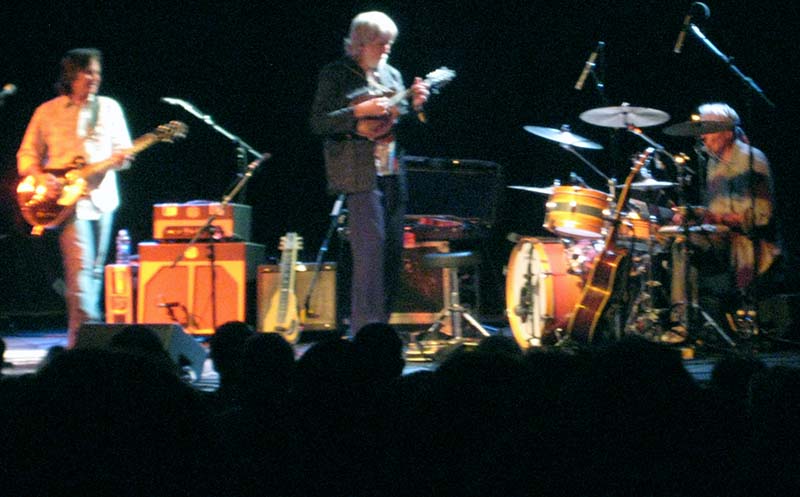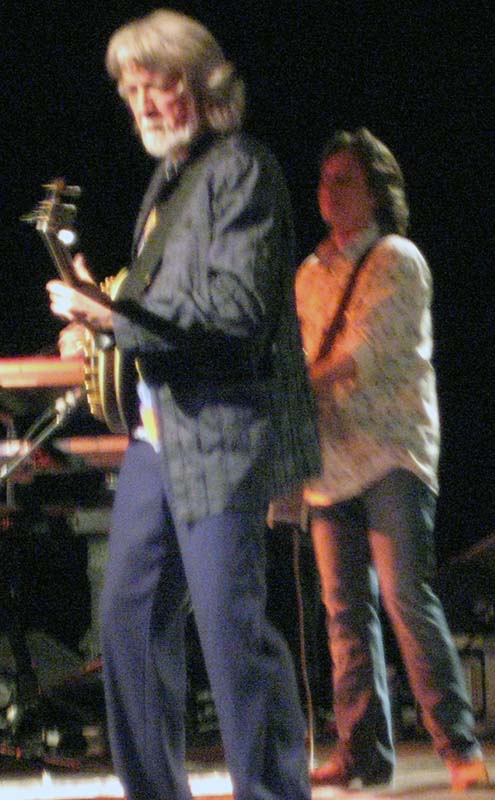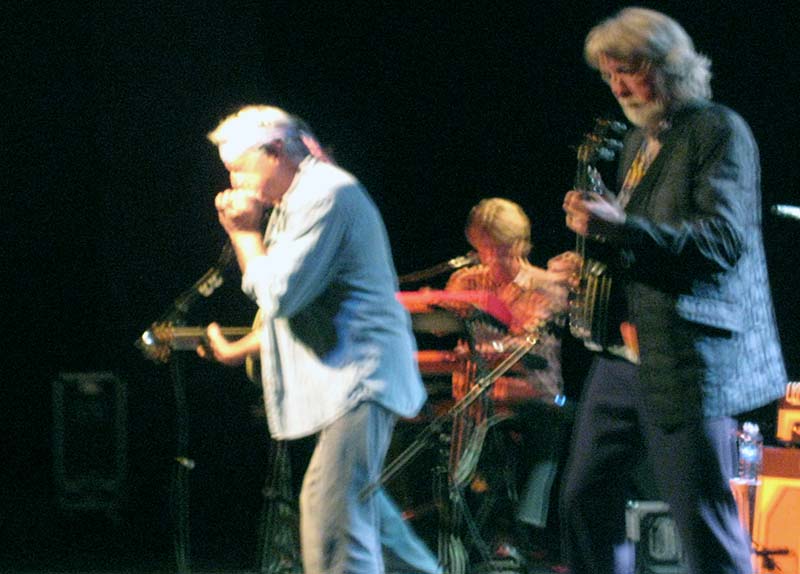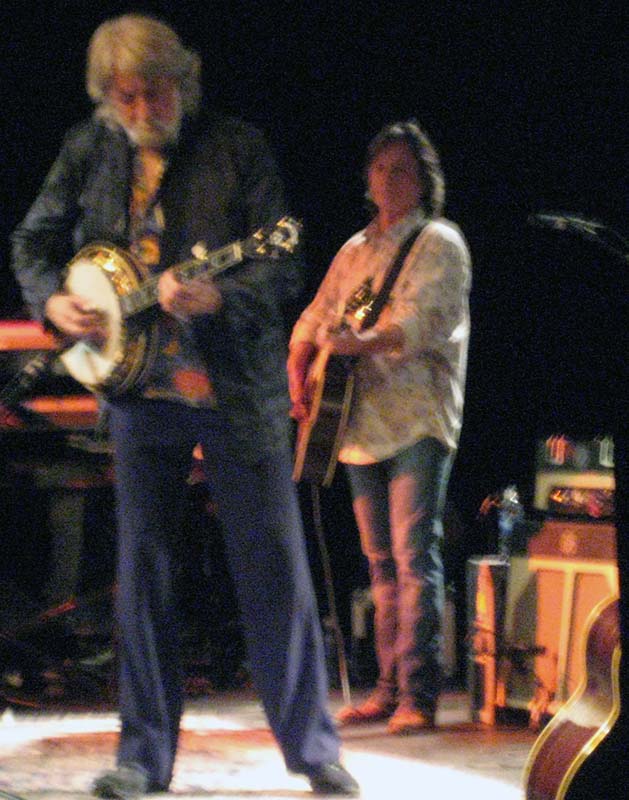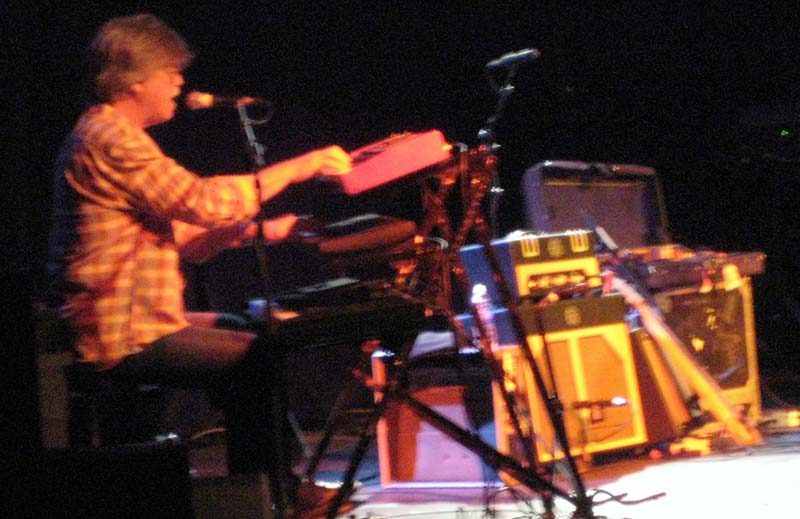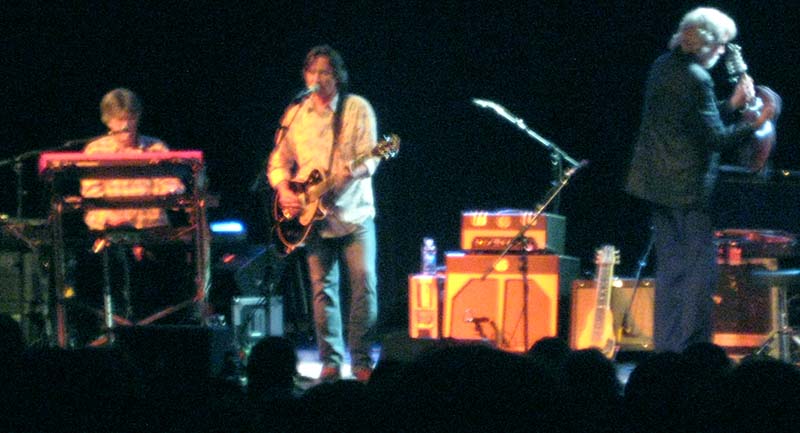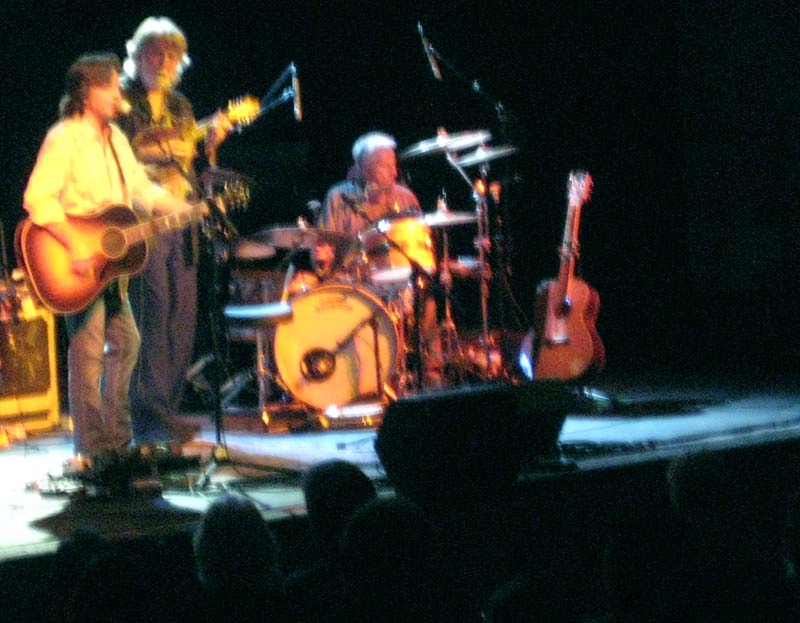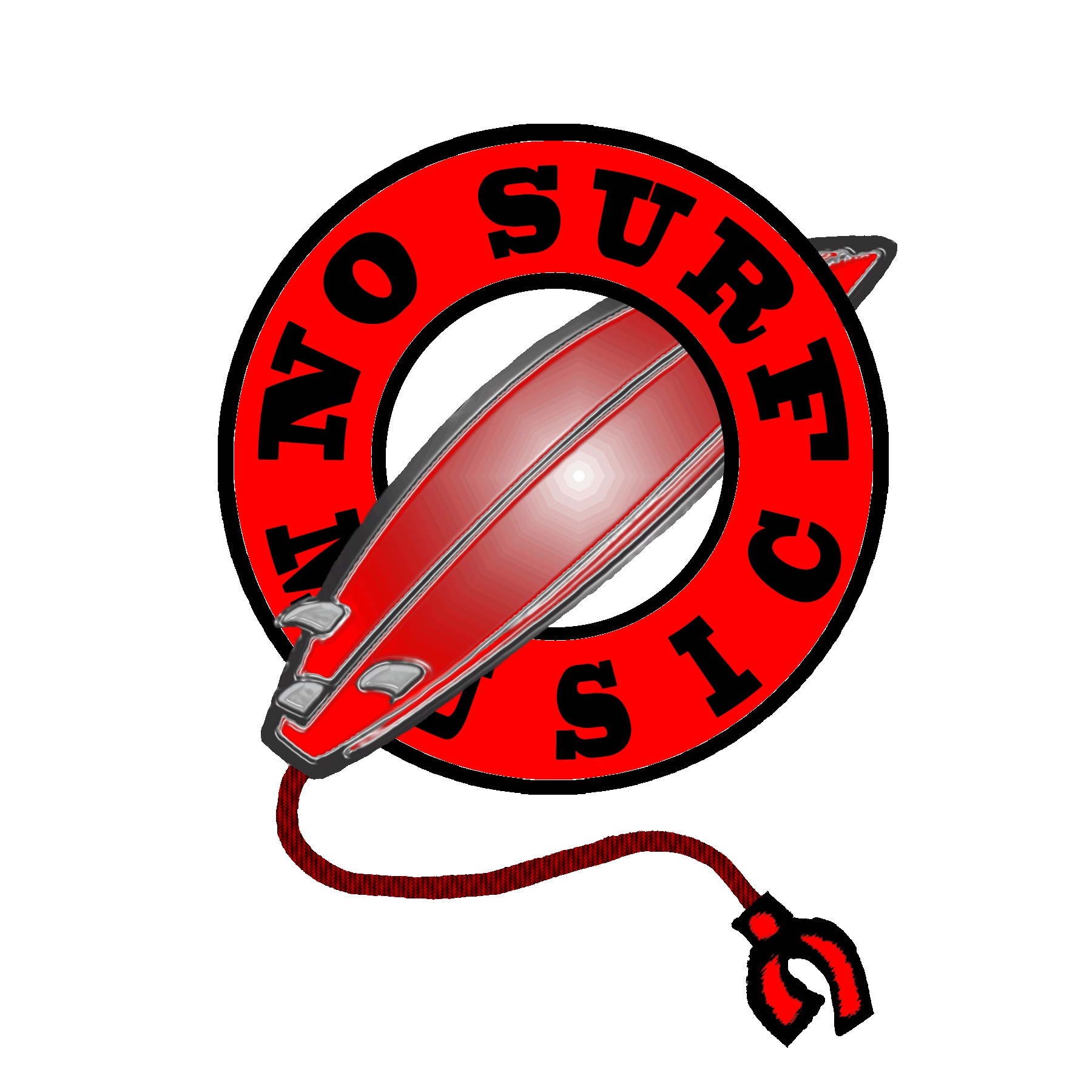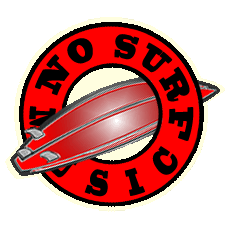
The Lowdown:
June 27, 2011
The Nitty Gritty Dirt Band: Bob Carpenter, Jimmie Fadden, Jeff Hanna and John McEuen
by Jason D. 'Diesel' Hamad
The Nitty Gritty Dirt Band performs live at the Kent Stage following their Burning River Fireside Chat. (l-r) Jimmie Fadden, Bob Carpenter, Jeff Hanna, John McEuen. Photo by Jason D. 'Diesel' Hamad, No Surf Music.
The Nitty Gritty Dirt Band started out in Long Beach, California way back in 1966. Early on they were a jug band but they quickly transformed themselves into something new, becoming one of the very first country rock groups. By the close of the decade their sound had gained national resonance and propelled them onto the charts with a string of hits, including their legendary version of “Mr. Bojangles.” On their 1972 album Will the Circle Be Unbroken they joined forces with a who’s who of old-time country and bluegrass stars, and the project has become legendary, influencing generations of country players. It’s safe to say that every Americana, roots, and alt.country band that followed owes part of their sound to the Dirt Band, whether they know it or not.
The group has gone through a lot of lineup changes since they started, but today’s Dirt Band is composed of a four-man core that has been through it all. Guitarist Jeff Hanna and drummer/harmonica player Jimmie Fadden were both founding members. Multi-instrumentalist John McEuen joined only a few months later. And the “newest” member, keyboardist Bob Carpenter, has been with the group since 1977.
Throughout their career they’ve played all over the world and continued to make new and exciting music. They’ve stayed relevant, paradoxically, by remaining true to their musical roots. Their latest album, 2009’s Speed of Life (see No Surf Review here), was recorded live in studio to recreate the feel of their early releases.
Before their show June 4th at the Kent Stage in Kent, Ohio (see North Coast Nights review here) all four members sat down with No Surf to discuss the band’s long history and what they’re up to these days.
No Surf: So the Nitty Gritty Dirt Band has been on the road pretty much forever. How has this latest tour been going since Speed of Life came out?
Jeff Hanna: It’s been great! It’s been about a year and a half since our last album and we’ve played all over… actually ended up in Norway once since then.
Bob Carpenter: Yeah, we’ve been all over the United States and Canada, and we’ve done everything from big outdoor festivals to performing arts centers to theaters like this.
JH: Like Levon [Helm]’s Ramble in Woodstock. We played Bonnaroo last year, which was great. Those were really fun gigs.
NS: Big crowds, too, right?
BC: Big, hot, sweaty crowds.
JH: Not so hot and sweaty in Woodstock, but Bonnaroo was like, whooooo, boy! They could have picked a better time to do it. Tennessee is warm in June!
NS: How would you say touring today compares to the tours you guys have done in all the years past?
BC: Travelling overall is harder.
John McEuen: It is?
JH: Well, it’s more complicated.
Jimmie Fadden: Yeah, there’s more rules about travel.
BC: We used to be able to just drag our equipment around, and now you have to send it through a bonded company. Sometimes you can’t just throw it on the airplane like we used to because of 9/11. You know, all the stuff you have to go through at the airport... It seems like it’s much more crowded. There’s less flights. It’s more expensive. There’s more delays. It’s just more problematic travelling these days than it used to be. Before we could just get there a lot easier than we can now.
JH: It’s more complicated. We still do it.
JM: A different perspective… I think it’s easier to get anywhere. There’s more airports, more airlines, there’s more rental cars and trucks. The equipment part is difficult and that requires sending road crews out earlier.
BC: Oh… you’re comparing it to when you used to travel before there were airplanes!
JF: But there were times when our equipment didn’t get there. The band would go to the airport, the crew would drop the stuff off at airfreight, and then we’d get to the other end and wait for the equipment and sometimes they’d say, “Well, it didn’t make that plane, and it may come in later tonight.” That was a long time ago.
These guys really seem to enjoy putting on a show, and apparently they'll play just about anywhere. Photo by Jason D. 'Diesel' Hamad, No Surf Music.
JH: That’s just the travel part. The venues are by and large really similar, if you think about it. We’ve been playing small theaters, clubs, fairs, big festivals, performing arts centers, sheds…
BC: Casinos…
JF: Hockey arenas…
JM: One thing that’s nice is the sound systems are all better…
JH: Oh that’s absolutely true.
JM: …the lighting systems are better. In general the staging is better.
JF: The food backstage is pretty much the same, but the hot meals are better.
JH: The food’s better, yeah, because it’s less often they say, “How many pieces do you want in your bucket of chicken?” Seriously, it’s kind of evolved and they realize this is how our day goes… if they can provide us with dinner that would be great, you know?
NS: What about crowds? How has your fan base evolved and how many people have stayed interested in the music?
JH: There’s been a generational shift, in that the people who grew up on our music are still coming to the shows—which we’re really grateful for—and they’re bringing their kids, and some of them are bringing their kids now. Dirt Band fans are very loyal and we appreciate that, and we’ve grown our audience, as they say, and some of it’s just been within the families of the folks that started out with us in the 70’s.
JF: It’s amazing how parents have actually taken our music and made it a part of their children’s lives, and with respect to the fact that [the kids] could just say “no,” for the most part they haven’t. They’ve really enjoyed the whole thing and then, like Jeff said, brought their kids along, too. You know, it used to be “My mom played your stuff for me when I was really small.” Now it’s “My grandma played your stuff for me when I stayed at her house.”
BC: We’ve been fortunate, too, that we’ve had career songs in a bunch of different decades. So the people who were kids when “Fishin’ in the Dark” came out got turned on to “Bojangles” and vice versa, they’ve all sort of come along and got turned on to the different decades of music that the band has produced and it’s made for really loyal fans and a wide age group.
NS: I think for most people who aren’t really deep into music, they hear “Nitty Gritty Dirt Band” and they think of just one song, which is “Mr. Bojangles,” because that’s the one that gets played on the radio all the time. It’s great that people are still listening to it, but it’s also a shame because you’ve been around since 1966 and you’ve had an impressive career. But since “Mr. Bojangles” is your most remembered hit, I want to ask about Uncle Charlie and His Dog Teddy. What was it like finding that success and did that really change things for the band?
JH: Well, we’d had a pop hit called “Buy For Me the Rain” back in 1967. It was on our first album and it went top 40 on the charts. But our band’s identity was kind of skewered because we started as a jug band. I mean way rootsier than we are now, in the folk litmus test. So we had this pop hit that was kind of folk rock by definition, and we had a little identity crisis because were playing all this old blues and ragtime music and then we did this “hit.” The hit got people in and then we’d play all this other stuff.
In ’69 when we started playing country rock—which was a relatively new form of music—we found a focus we didn’t have in ‘66 when we started. We managed to make a living at it for the first three years. But a couple of the guys left and a couple of the guys came in and we found something that we all agreed on, which was taking our influences—everything from Flatt & Scruggs to Buddy Holly to the Everly Brothers—and applying it to this new music. And that’s kind of become the center of what we do since then.
JM: I agree that a lot of people identify the group with Boangles to an immense amount, but if you go to certain parts of the country, “Fishin’ in the Dark” was a whole new world to people that, like Bob was saying, get reverse engineered. They find out later… “gee, that sounds like that old record… oh no that was them, too.” And prior to that, the first number one song, “Long, Hard Road,” was seventeen years into the career and ten, eleven years after “Bojangles.” So it’s a weird group because it’s had four different imprints. Jeff wrote a song called “Make a Little Magic” that you can hear in the grocery store every now and then. The Dirt Band is one of those groups that people come and say to the person standing next to them “Did they do that song. They sound like the band that did that song.”
JH: That happens two or three times in the concerts.
BC: It happens a lot with “American Dream.”
JH: “American Dream” is a big one, yeah. They go “oh, that was them.”
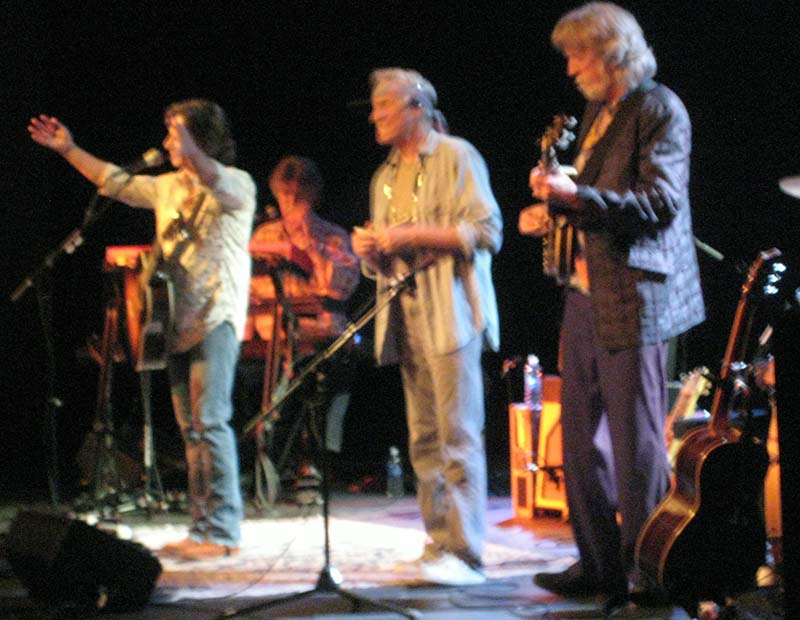
They may be from a different latitude and have something of a different attitude, but sure, these California hippie types can be Buffety when they want to. Photo by Jason D. 'Diesel' Hamad, No Surf Music.
JF: Probably the thing is which piece of which root is more identifiable in each song? Some people gravitate towards this entrance point because of this song, like, say, “American Dream,” which has more of a…
JH: …Buffetty feel.
JF: Yeah… trop… kind of…
JM: ...tropical.
JH: …Buffetty.
JF: Yeah…
JH: It’s Buffetty. It’s Buffetty music.
[laughter]
JF: Yeah, that’s it… Buffetty feel… and they say, “Oh, I really like this particular song,” and think everything else is going to be the same. Well, little do they know we’re gonna mess with their mind at some point.
JM: When “American Dream” was on the radio, we were doing a show with Buffett and one by one his band members came in and said, “We told Jimmy he should have done that song!” and then the last one to come in was Buffett saying “I should have done that song!”
JH: It’s really hurt him as you can see.
JF: As a result of songs like that, though, we were able to afford better equipment… Jeff got an amp that went to 11. We just took off from there.
NS: I wanted to ask you about my personal favorite project that the band’s done…
JH: …Will the Circle Be Unbroken…
NS: Exactly! The man already knows me. It was such a cool collection and such a great idea because I’m really into that older music and you guys, through that project, really got to live that out with all the folks that you played with and all the songs that you covered. On the record you played with Roy Acuff, Earl Scruggs, Jimmy Martin, Mother Maybelle Carter, Doc Watson, Merle Travis and a bunch of others. What was it like, not only getting to meet these people, but bringing the two generations together?
JH: It was phenomenal. We were drawing upon our roots—the music we grew up with—starting with folks like Mother Maybelle Carter. John and I would both agree—and Jimmie, probably, too—learning “Wildwood Flower” on the guitar was a big deal. So going back to first being folk puppies before there was a Nitty Gritty Dirt Band, as individuals sitting around swapping tunes with our friends… you know, the influence of Earl Scruggs, huge. The influence of Merle Travis, huge. We actually got to play with Merle Travis. He was the one guy in that project that we had actually spent a week playing with at the Ashgrove Club in California when we were a jug band. So that was really cool to reconnect with him a few years later. You know, Doc Watson’s a huge influence on all of us.
JM: The Nashville Tennesseean had said “Why the Nitty Gritty Dirt Band is in Nashville recording with a bunch of old dinosaurs we don’t understand,” so that kind of worried us and we thought, “How is it going to be when we start recording?” But we got into the studio and found out that we were just players from California, and generally they kinda liked us… “Jeff’s a nice guy, and Jimmie plays good harmonica and there’s a banjo player and that guy’s got a guitar…” but we found out that they were fans of each other.
[breaks into Mother Maybelle impression] “Oh, Roy, I’ve always wanted to make a recording with you, and we’ve seen each other so much…” and Doc wanted to meet Merle, and Merle wanted to meet Doc…
JF: Yeah, “I named my son after you…”
JM: …and the bass player had played with all of ‘em. And Merle had never recorded with Roy… and they were all fans of each other, and that kind of took over and we got to watch them do that.
JH: Without getting too cosmic on you here, there was a serious aligning of the planets on this thing. And here we were—truthfully—we’re in there making a record with our heroes. Period. You know? Whether or not we realized that this was crossing this huge generational gap, cultural gap, I was just happy to be there playin’ in the room with Doc Watson. I mean, I’d seen him play a million times, but I never got to pick and sing with him!
JF: I think some of us realized that in the process of getting there we had played with several people of that ilk or notoriety and found that there was some compatibility. Like I sat in with Lightnin’ Hopkins. John played with the Dillards a lot…
JH: Didn’t you play with the New Lost City Ramblers?
JM: No, the Greenbriar Boys.
JH: Well, even better.
JF: So there was some kind of tuning up in our lives… I mean, as players, we were starting to become more socially integrated with a greater variety and stature of performers.
JH: We weren’t interlopers. We weren’t fakin’ it.
JF: I think the fact that we were younger was the only disparaging point.
Stringed instument master John McEuen, the Dirt Band's "old banjo player." Photo by Jason D. 'Diesel' Hamad, No Surf Music.
JM: You know when Earl did that he was like the old guy, you know? The old banjo player. I’m seventeen years older than he was when he did the Circle.
JH: How old was he, 45?
JM: 45 or 48…
JH: Yeah, he wasn’t 50. It’s crazy.
NS: I just saw him a couple years ago at Stagecoach out in California…
JH: He’s still got it!
NS: He does! You know, it can’t be the same as back then or even before, but every so often he sort of creaks up and just goes at it. It’s amazing.
JF: The nice thing was that this acceptance was cross-generational. It didn’t have anything to do with how old anybody was once we got in there and started playing.
JM: One of the strange reasons Will the Circle Be Unbroken happened—and Jeff calls them cosmic—was because before then he had heard Jerry Jeff Walker doing “Bojangles” one night driving home from rehearsal. He came back the next day and said, “We oughta learn that!” That song ended up with mandolin, accordion, acoustic guitar… We did “Some of Shelly’s Blues” with frailing banjo, and there was instrumentation like that, so when the kids of Jimmy Martin, young Jimmy, and the Scruggs kids, and Doc’s son Merle heard that…
They were looking for new music. They had these traditional parents. In fact, Merle told me, “I played some of that Uncle Charlie album for my daddy and he liked it! He said he liked the way that that stuff sounded, and you had ‘Clinch Mountain Backstep’ on there! You know he knows Ralph Stanley!” There was already a connection that we were making without knowing it to the younger generation that helped tell the parents, “Can you record with them?”
JH: Because of the Uncle Charlie record.
JM: I would say that was the door that opened.
JH: Uncle Charlie was the most important record we’ve made in our career because of the doors that it kicked down.
JM: And one of the strange things about the Dirt Band… Here’s a group that had three hit records on the charts within a year--“Some of Shelly’s Blues,” “Bojangles,” and “House at Pooh Corner,”—and went to Nashville to make an acoustic bluegrass album…
JH: …of old-timey music.
JM: We could have ended out career. The risk was taken blindly, let’s just say. I don’t think Jimmie was saying, “You know, we gotta get back on the pop radio.” It was more like “Can I play behind Merle on this one?” or “I’m gonna play with Doc!” I can picture Jeff now, leaning over Doc’s shoulder… [grabs my shoulder, knocking down equipment in his excitement, and sings] and lookin’ happier than…
JH: Yeah, Doc’s microphone, guitar and vocal about where you’re sitting and I leaned over his shoulder singing harmony. It was real!
JM: And I’m sitting there frailin’ the banjo feeling like Clarence Ashley!
Jimmie satisfies another root craving with a bit of harmonica on stage. Photo by Jason D. 'Diesel' Hamad, No Surf Music.
JF: It was the satisfaction of a major root craving, ya know? I mean, this music was really a part of our lives. Somehow we identified with that, and so when it came back through us and came out in front of them it was like, “Whoa, ok!” We were just all about connecting with the source of our inspiration. It was flammable at times!
JH: One of the things John touched on a second ago, too, is that if you take “Mr. Bojangles”… the success of that song, a top 10 pop single, a million copies sold, our recording is now in the Grammy Hall of Fame, which we’re proud of… you know, a big deal… but what that did is, it gave us the key to the door, because of that airplay, to have the power to be able to go into a record company and say, “We want to do this other thing…” Here we are, all over the radio, and we want to go make an acoustic record.
JM: Record companies were malleable then. My brother and I went to the president of the label [Mike Stewart of United Artists] to do the pitch to raise the money, and he sat there and listened and after about twenty minutes he goes, “Sounds like the band is really passionate about this, and I’ll put up the money.” $22,000.
JH: Total budget.
JM: Twenty years later I’m talking to Mike Stewart, who is now a big showbiz mogul and in the publishing world, and I said, “Mike, I’m sure glad we knew you back then,” and he goes, “Well let me tell you something, John. I’ve been responsible for probably a thousand albums. I’ve got three on my wall in my office. I’ve got Tina [Turner]’s album that I made happen, the Imagine album, and the Circle album.” I think he was very proud of that. He said, “Just those three alone would have been enough.”
JH: If we had come to him prior to the Uncle Charlie album he probably would have said, “I don’t think this is happening.”
JM: We got turned down by every label in L.A. twice in the early days. So that’s the way it was. Once you had that stamp of credibility, it bred fear in the group. The kind of fear where Ike Turner could walk in and say, “I need $35,000 cash by 3 o’clock,” and he’d have it.
JH: Yeah, he was always packing, though!
NS: That might have helped.
JM: Ike and Tina were on the same label as we were.
JH: We did some shows with them, actually. It was awesome. They were so great.
JM: We didn’t know any of the stuff going on at the time, it was just like, “Wow!”
NS: I want to jump onto one thing that I think Jeff was about to say a while back, which is that Will the Circle Be Unbroken was a once in a lifetime experience…
JH: Well, it was a life changing experience.
NS: Ok, fair enough. One of the things that I think is so interesting and which shows the reverence you guys still have for that kind of music is that almost twenty years later, you went back and did it again and brought back a lot of those same folks from the first album and even more. Did it have the same kind of feeling, or did it feel less special the second time around?
JH: It just felt different special, because in the case of the second Circle record we were playing with a lot of people who were influenced by the first record, so they were kind of honoring us. Although we weren’t… let’s see, ’89 [pauses to do math in his head], we weren’t quite as old as Earl Scruggs was when he did the first one, but we were in our 40’s then, so we were definitely adults.
JM: Close! Middle generation. And then by Volume 3, they were comin’ to play with the old guys!
JH: Yeah, by Volume 3 we had our kids on the record. John’s and my sons sang.
McEuen belts out a little somethin' on 5-string banjo while Hanna strums along. Photo by Jason D. 'Diesel' Hamad, No Surf Music.
JM: And the thing on Volume 3 that I noticed was that we had become a conduit for a lot of artists who said, “I always wanted to record this song!” Like when Alison Krauss did “Catfish John.” She couldn’t really do “Catfish John” on an Alison Krauss album. It was too… something… it was too old country, but she loved the song. So she did that. And Del McCoury would love to sing a Reno & Smiley song, so they could do that. They can step out. They can step into our circle and let us join up with them. That’s where I saw a transition of the material that they wanted to do, whereas when we recorded with Acuff, we did Acuff songs, and Earl did Earl songs. You know, everybody did their own stuff. It wasn’t like Acuff singing a Bill Monroe song.
JH: It’s a different significance. I mean, it’s really hard to say… Was the first one the most important? Yeah, absolutely.
JM: I think the third one was really important, and overlooked.
JH: Oh, I do, too, but the second one was great, and I think it was not overlooked.
JM: It got a lot of recognition and notice, and that was all good. Got a lot of airplay.
JH: It’s some people’s favorite Circle record, believe it or not.
BC: It got more exposure in a shorter amount of time because of the first one and because it won those awards.
JH: Won three Grammys and it was CMA Album of the Year. But not only that, oddly enough, these kids that I meet that are young songwriters coming to Nashville now, they say, “I love that Circle record!” and I think they’re gonna say “Way Downtown” and they go, no, “Life’s Railway to Heaven” or “The Valley Road.”
JM: It’s like the bluegrass band that was on after us last night. I walk up to them and say, “Hey, let’s play ‘Fireball Mail”! and they go, “What’s that?” What! A bluegrass band of young people that don’t know “Fireball Mail”? Oh, God, no!
JH: They’re gonna go, “Let’s do something old-timey like the Newgrass Revival!”
JM: Let’s play “Fox on the Run,” or something that’s really old.
JH: Sam Bush’s version of “Eight More Miles to Louisville.” This is geezer speak, but you forget how quickly the time passes. Those guys aren’t kids anymore.
JM: And you can’t go too far without mentioning Vassar Clements. I knew Vassar was great, but I didn’t know how much I’d heard him. And we were constantly learning in the years after the first one.
“Hey, Vassar, can you show me how you’d play ‘Uncle Pen’?” And he plays “Uncle Pen” on the fiddle.
And I say, “Did you learn that off of that Bill Monroe record?”
He goes, “John that was me on that record! I was seventeen!”
I said, “Oh, my God! I didn’t know that!”
Vassar was on all kinds of records that I found out about later… I didn’t know I’d heard him with Jim and Jesse… No album credits.
NS: Well you guys helped reintroduce him to a whole new audience.
JM: He would always say, “I have a career because of that album.”
Merle Watson said to me, when I told him that we wanted to ask Doc to be a part of it, “Well, daddy needs this, ‘cause the folk music thing is dyin’! Our crowds have been goin’ down for the last three years.”
The place that I went to see him to ask the question there were only about 110 people in a 300-seat room. He was really glad for his dad to have something that moved him up, which it did. But he was only being ignored because of the way things were going in the music business. It was his talent that brought him out to the front. I always felt like Doc was a real star. All those people were. That’s why they’re on the left side of the credits.
NS: Tell me about the newest record, Speed of Life, and how that idea came about.
The Dirt Band's "newest" member, keyboardist Bob Carpenter, who joined up in 1976. Photo by Jason D. 'Diesel' Hamad, No Surf Music.
BC: As far as the inception goes, there’s always something that gets us recording. The days of having to deliver an album because we’re under contract to a record company are long gone, so we have to really want to make a record, the circumstances need to be right, and there’s always something that starts it out.
In this case, it was the opportunity to work with George Massenburg, who is a great engineer—a Grammy-winning engineer—and inventor, and producer. We’ve always wanted to work with him, and at the time he was working with Jon Randall Stewart, who’s a Grammy-award-winning songwriter and a great player.
The opportunity came up to work with them and we loved George’s concept, which was to get back to the vibe of Uncle Charlie and also grab the intensity of recording in a live situation like the Circle projects. So that combination made us want to do the project and we just started bringing material and—lo and behold, talk about the Scruggs family—Earl’s son Gary wrote a song called “The Speed of Life” and we felt that it spoke to us and we wanted to call the album that.
NS: I know you guys were trying to take a step back, almost, in respect to the way that music has become overproduced and all the focus is on playing with the bells and whistles afterwards. Why was that so important to you?
JH: It wasn’t as important to us as it was to our producers, because they were fans of Uncle Charlie and the Circle records. They just felt like, as fans, that was the Dirt Band they wanted to hear, and they got their wish. It was great for us. It was hard. The initial adjustment of, for example, me playing acoustic or electric guitar and singing live—something I hadn’t done outside of the stage ever—you know?
BC: Well, except for the Circle records.
JH: Yeah, but it’s different playing electric, and it’s different singing. We’re surrounded by a different bunch of guys, you know? And Jimmie’s drum kit was sitting in the middle of the room… This room that George Massenburg designed…
BC: It was non-reflective.
JH: Right, but he had microphones placed all through the room. The people at these amazing classical venues never mic their stuff like this. There was shit hanging everywhere.
JF: He’s the mad scientist.
JH: But unbelievable. He’d sit there and listen to this mix and go, “Bob needs to hit the piano just a little harder,” and Bob’s going, “I’m hitting it as hard as I can! Turn it up,” and he says, “No, if we turn the piano up then we start losing the room!”
It was always about the room. The room was the other guy in the band and you can hear it in that record. It was this amazing vision that George had, that we cut through it and got. And capturing the tunes with the passion of playing ‘em live is great… Once we got past the fear factor.
BC: The other thing about affecting the music too much is if you have songs that are good enough to stand up on their own, by producing them in a way that makes them current with what’s on the radio and all those bells and whistles, I think shortens their life span and when you look back on them, they don’t look as good to you—sort of like looking at pictures of me in the 80’s when I had this huge mullet… you go, “What was I thinking?”
JH: You mean a cheesy arrangement on a song can make you dislike it?
BC: Or the wrong kind of effects, or just trying to do something that’s current to get on the radio or keep up with what the latest hit is. When you look back on it a couple years later it doesn’t last, because you ruined it in a way by not keeping as pure as it could be. Depending on the song. We tried to pick songs for this record that stood up well in this type of production, that didn’t need all that stuff.
JF: Without the syn-drums.
[both Jimmie and Jeff start air drumming, with ping-poing-ping effects]
BC: Well now you’re really dating yourself.
The Dirt Band worked to create the feel of live environment on their latest album, Speed of Life. Photo by Jason D. 'Diesel' Hamad, No Surf Music.
NS: And you wrote or brought in new materiel for all but two of the songs on this album, which considering that you were going for this older feel was interesting. You didn’t just want to redo Circle or something like that.
JH: No, no no no no. And in fact, on the covers there was really only supposed to be one. I should say “classic,” because people have different definitions of “covers.” To some people it’s a cover if you didn’t write it, to other’s it’s a cover if they’ve heard it before by somebody else. In the case of “Goin’ Up the Country,” Jimmie’s been talking about doing that…
JF: …for years…
JH: We hit the perfect way to do it. The idea of doing it sort of as a throw back to the jug band was a perfect fit for us. We didn’t intend to do “Stuck in the Middle.” We had just finished recording “Goin’ Up the Country” and George Massenburg said, “Would you guys do me a favor?” And we were like, “Yeah…?”
JF: I had been playing that with my little jam band buddies down in Florida and we’d been having a lot of fun and everybody really loved it and I thought, “This is a really cool, funky song.”
JH: I always loved the song, too, but I felt the definitive version had been recorded already by Stealer’s Wheel—and as it turns out afterwards had been covered by about ninety artists—but George said, “You guys have hit on something with this arrangement that you’ve done on ’Goin’ Up the Country,’” so we played with it. One of the feels sounded almost bossa nova… So we ended up finally with that sort of goofy… it’s sort of like Mungo Jerry… [sings] “In the summertime / when the weather is…” That old sixties hit. It’s like a skiffle band…
JF: Nobody remembers that…
NS: [smiling] I’m a music freak so… What can I say?
JF: You know the song?
NS: Sure!
JH: But George was right. It was really fun doin’ that! The only thing that I regret about it is people always bring up those two covers and I think the other eleven songs are more significant.
But it was cool. It was a great experience. John Randall, in case you’re not familiar with him, was a member of the Nash Ramblers, Emmylou’s acoustic group that she had in the early ‘90’s. He won a Grammy with them, and he was in his 20’s back then. He’s had a really great career. He played in the Sam Bush Band for a while and he’s done three or four records on his own that are just genius, great records.
JF: And he’s written some big songs!
JH: One of the bright spots in country music in the last ten years was a song called “Whiskey Lullaby” that was a huge hit for Alison Krauss and Brad Paisley, and John Randall wrote that and won a CMA Song of the Year… beat me.
Look for some new live projects from NGDB later this summer. They'll be like this, only a little less blury. Photo by Jason D. 'Diesel' Hamad, No Surf Music.
JF: Plus, he could tell you where every Chik-Fil-A was between Nashville and Dallas. You need a guy who has that kind of knowledge.
JH: So George was the mad scientist with all the technology and the studio skills and John Randall was the music guy.
NS: Are there any plans to do any other recording projects in the future?
JH: You know, we’ve got a live project that we’re toying with, so you may see that surface a little later in the summer.
JF: Yeah, some EP’s. Some six packs.
NS: Well, we’ll be looking forward to that.
And we will. It was an undeniable pleasure to speak with legends such as the members of the Nitty Gritty Dirt Band, but what is most amazing is that after more than four decades they show no signs of slowing down. Their latest release, Speed of Life gets them right back to the roots feel that made the band so great (see No Surf Review here), and their live performances continue to be absolutely top notch (see North Coast Nights review here). If their next project captures even a hint of their live energy, it will be well worth checking out, and we’ll be sure to keep you posted. Meanwhile, NGDB is always on the road, so look for them to swing by your town soon!
| mp3 | cd |
|---|---|


